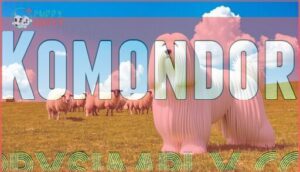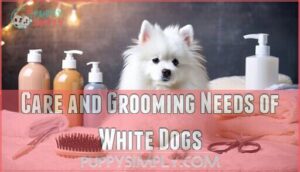This site is supported by our readers. We may earn a commission, at no cost to you, if you purchase through links.

Whether you’re seeking a family-friendly Havanese or an independent Coton de Tulear, white dogs require regular grooming to keep their stunning coats immaculate. Each breed brings distinct care needs that’ll shape your daily routine.
Table Of Contents
- Key Takeaways
- Best Small White Dog Breeds
- Popular Large White Dog Breeds
- White Dog Breeds With Unique Coats
- White Dog Breeds for Families
- Care and Grooming Needs of White Dogs
- Frequently Asked Questions (FAQs)
- What are some of the challenges of owning a white dog?
- What are some of the benefits of owning a white dog?
- What are some of the most popular white dog breeds?
- How do you take care of a white dog’s coat?
- What are some of the things to consider when choosing a white dog breed?
- Do white dogs get sunburned more easily?
- Are white dogs more expensive to buy?
- Why do some white dogs turn yellow?
- Do white dogs have more allergies?
- Are white dogs harder to photograph well?
- Conclusion
Key Takeaways
- You’ll find white dogs in every size – from 4-pound Maltese to 100+ pound Great Pyrenees, so there’s a perfect fit for any living situation
- White coats demand serious grooming commitment – daily brushing, regular professional grooming, and constant stain monitoring become your new routine
- These breeds face unique health challenges – up to 30% may develop congenital deafness, plus increased sun sensitivity and skin conditions compared to darker dogs
- Family-friendly options abound – breeds like Bichon Frise, Havanese, and Samoyed excel with kids and other pets when properly socialized
Best Small White Dog Breeds
If you’re looking for a compact companion with a stunning white coat, small white dog breeds offer the perfect blend of beauty and personality. These pint-sized pups range from the silky-coated Maltese to the spirited West Highland White Terrier, each bringing their own charm to your home.
Maltese
Looking for a pint-sized companion with elegance to spare? The Maltese delivers aristocratic charm in a tiny package. These toy dogs sport silky coat finesse that flows like liquid silk.
Maltese magic: aristocratic elegance in a fluffy, silk-coated package that steals hearts instantly
Their gentle nature makes them ideal small companions for apartment living. Despite their delicate appearance, these white fluffy dogs pack surprising personality.
Daily brushing keeps their white coat dogs gleaming.
West Highland White Terrier (Westie)
The West Highland White Terrier brings Scottish charm to your home with boundless energy and an affectionate personality. This Small Breed requires Terrier Training to channel their independent streak, while White Grooming maintains their bright coat.
Westies thrive on quality Dog Nutrition and make excellent Small White Dogs for active families. Their Westie History as hunters shows in their confident nature, making them standout White Fluffy Dogs among White Coat Dogs varieties.
Like other small dog breeds, they require regular small dog care to stay happy and healthy.
Bichon Frise
The Bichon Frise brings a cheerful powder-puff personality to your home. This breed’s gentle nature makes them perfect companions for families, while their playful traits keep everyone entertained.
Their adaptable size fits most living spaces comfortably. The Bichon’s low shedding white coat requires regular grooming but won’t leave fur everywhere, making them ideal small white dogs.
Coton De Tulear
The Coton de Tulear brings royal Madagascar heritage to your home with its cotton-soft White Coat Colors. This rare gem from Tulear Genetics boasts Fluffy Coats requiring brushing three times weekly.
Their Gentle Nature makes them perfect lap dogs who thrive on human connection.
White Grooming stays manageable with their low-shedding texture, though daily attention keeps their signature fluffiness spotless and healthy.
Havanese
You’ll find the Havanese among the most charming small dog breeds, with their shiny coats coming in multiple white coat colors including pure white. These compact companions usually weigh 7-13 pounds, making them perfect apartment dogs.
Their Havanese history traces to Cuban nobility, developing friendly Havanese behavior that thrives on human interaction. Daily Havanese exercise needs are moderate – short walks satisfy their energy.
Proper Havanese nutrition promotes their silky coat health and overall well-being.
Bolognese
Looking for something rare and special? You’ll treasure the Bolognese, a hidden gem among White Dog Breeds.
This Italian rare breed brings gentle nature and unwavering loyalty to your home. Unlike Big White Dogs or Large White Dogs, these small companions weigh just 5-10 pounds but pack enormous personality.
Their fluffy, low-shedding coat requires minimal grooming while maintaining that flawless white appearance. White Dog Temperaments don’t get sweeter than this laid-back charmer.
Popular Large White Dog Breeds
If you’re looking for a gentle giant with a stunning white coat, large white dog breeds offer the perfect combination of impressive size and beautiful appearance. These majestic dogs range from the laid-back Great Pyrenees to the fluffy, energetic Samoyed, each bringing their own unique personality to your family.
Great Pyrenees
Great Pyrenees stand as true Gentle Giants among Large White Dogs, weighing 85-120 pounds with majestic Mountain Origins in the Pyrenees between France and Spain. These Big White Dogs excel as Livestock Guardian Dogs, using their powerful Guarding Instincts rather than Herding Abilities to protect flocks from wolves and bears.
This Large Breed combines independence with devotion, making them notable White Dog Breeds for experienced owners. To guarantee their well-being, owners must consider their dog health needs and provide proper care.
Samoyed
Known for their smiling faces and sturdy build, Samoyeds bring arctic charm to your home. This breed’s thick coat and friendly temperament make them perfect cold climate companions with high energy needs.
Originally bred by Siberian nomads, Samoyed history reveals working dogs who pulled sleds and herded reindeer. Unlike smaller white dog breeds like Bichon Frise or Maltese, these fluffy giants require substantial exercise and thrive in cooler temperatures.
Kuvasz
The Kuvasz stands as Hungary’s majestic guardian, bred centuries ago for livestock protection. These Ancient Dog Breeds showcase impressive White Coat Genetics through their thick, curly coats. Unlike gentler companions, Kuvasz dogs retain strong Guarding Behaviors that require experienced handlers who understand Large Breed Care needs.
- Hungarian Herding heritage: Originally protected royal flocks in medieval Hungary
- Protective instincts: Natural Livestock Guardian Dogs with territorial tendencies
- Exercise requirements: Need daily physical activity and mental stimulation
- Grooming needs: Weekly brushing prevents matting of their dense white coat
- Training challenges: Independent nature requires consistent, patient Dog Breed Characteristics management
Komondor
With Hungarian origins stretching back centuries, the Komondor stands as nature’s foremost livestock guarding dog. This gentle giant’s corded coat care requires dedicated grooming to maintain those distinctive white dreadlocks. Their guardian dog behaviors shine through unwavering loyalty and protective instincts. Large breed training demands patience, as these independent thinkers prefer making their own decisions during flock guarding duties.
| Characteristic | Details |
|---|---|
| Size | 100-130 pounds, 25-27 inches tall |
| Temperament | Independent, protective, calm |
| Exercise Needs | Moderate daily walks, mental stimulation |
| Grooming | High maintenance corded coat care |
White Dog Breeds With Unique Coats
You’ll discover that white dogs showcase some of the most fascinating coat textures in the canine world. From the distinctive corded coats of Komondors that look like living mop heads to the silky elegance of Maltese fur, these breeds prove that white doesn’t mean boring.
Corded Coat Breeds (Komondor, Puli)
Rarely will you encounter White Dog Breeds more unique than the Komondor and Puli, with their naturally forming Corded Coats. These Hungarian Origins breeds developed distinctive "dreadlock" coats for Flock Guarding protection.
Corded Coat Care requires careful cord separation during formation, while Puli Grooming and Komondor Training demand experienced owners due to their complex Dog Grooming Needs and strong-willed temperaments. Understanding cord maintenance techniques is essential for the health and appearance of the Komondor’s coat.
Fluffy and Double-Coated Breeds (Samoyed, Japanese Spitz)
When exploring fluffy double-coated breeds, you’ll discover nature’s perfect cold weather companions with their luxurious, insulating coats.
- Double Coat Care – Daily brushing prevents matting and reduces white shedding issues throughout your home.
- Cold Climate Adaptation – These breeds thrive in cooler temperatures thanks to their thick coat grooming needs.
- Samoyed Distinction – Known for their "Sammy smile" and fluffy breed history as Arctic working dogs.
- Japanese Spitz Charm – Compact size with stunning double-coated magnificence requiring consistent maintenance.
Silky and Low-Shedding Breeds (Maltese, Poodle)
Some hypoallergenic dogs feature silky coats that’ll make your heart melt. These low-shedding breeds, including the Maltese and Poodle, offer a gentle nature with manageable coat maintenance. White dog breeds like these require daily brushing but reward you with stunning beauty. Understanding the poodle shedding process is vital for maintaining their unique coats.
| Breed | Coat Type | Grooming Frequency | Best For |
|---|---|---|---|
| Maltese | Silky, floor-length | Daily brushing | Apartment living |
| Poodle | Dense, curly | Professional grooming every 6-8 weeks | Active families |
| Bichon Frise | Soft, powder-puff | 2-3 times weekly | First-time owners |
| Coton de Tulear | Cotton-like, fluffy | 3-4 times weekly | Gentle companionship |
White Dog Breeds for Families
When choosing a white dog breed for your family, you’ll want to think about how well they interact with children and other pets.
Many white breeds like the Bichon Frise and Havanese are naturally gentle and patient, making them excellent companions for kids of all ages.
Breeds Good With Kids
When choosing Kid Friendly Dogs, you’ll find white breeds offer wonderful Family Oriented Breeds. Bichon Frise and Havanese score 5/5 for child compatibility. West Highland White Terrier and Maltese thrive with positive reinforcement from kids. American Eskimo and Japanese Spitz adapt well to household routines. For Gentle Giants, Great Pyrenees provide calm protection.
Follow Child Safety Tips: supervise small children with tiny breeds to prevent accidental injury. Families should research dog breeds suitable for their lifestyle to guarantee a harmonious household.
Breeds Good With Other Pets
When you’re building multi-pet households, certain white breeds shine as natural peacemakers. Pet-friendly dogs like the Japanese Spitz and American Eskimo adapt well to canine compatibility challenges through proper socialization techniques.
Top Multi-Pet White Breeds:
- Samoyed – Gentle giants that welcome furry siblings with open paws
- Maltese – Small but mighty social butterflies who love company
- Japanese Spitz – Naturally diplomatic with excellent household interactions
- American Eskimo – Playful mediators that reduce tension between pets
- West Highland White Terrier – Confident socializers despite their terrier spirit
Temperament and Trainability
White dog breeds offer varied temperament and trainability levels that make them excellent family companions. Bichon Frise and Coton de Tulear showcase high intelligence levels and respond beautifully to obedience training with positive reinforcement. Their socialization needs remain moderate, adapting well to family life.
However, breed temperament varies substantially—while friendly dog breeds like Maltese display emotional stability, some intelligent dog breeds like Westies can show behavioral issues without consistent training. Understanding dog breed trainability is essential for selecting the right companion.
Care and Grooming Needs of White Dogs
Owning a white dog means you’ll need to master specific grooming techniques to keep that immaculate coat looking its best.
White dogs also face unique health challenges and training considerations that require your attention and understanding.
Grooming Routines for Different Coat Types
Different coat types demand specific grooming approaches. Daily brushing prevents matting in silky breeds like Maltese, while weekly sessions work for Japanese Spitz’s fluffy double coat. Corded coats need careful separation techniques.
Quality grooming tools make shedding control easier—slicker brushes for mat removal, pin brushes for fluffier textures. Regular coat maintenance keeps your white companion looking immaculate. Understanding dog grooming techniques is essential for their overall health and appearance.
Common Health Issues in White Breeds
White dog breeds face unique health challenges tied to their genetics. Up to 30% may develop congenital deafness, while skin conditions and eye problems occur more frequently than in pigmented breeds. You’ll notice increased sun sensitivity, allergic reactions, and dental issues in many white breeds.
Dalmatians specifically struggle with genetic kidney disorders affecting one-third of the population, making regular veterinary monitoring essential for your white companion’s wellbeing. Proper use of dog health supplements can help mitigate some of these issues.
Training and Exercise Tips
Training white dog breeds requires consistent positive reinforcement and structured exercise routines. Most breeds thrive with mental stimulation through puzzle games and socialization techniques that prevent behavioral issues. Utilizing proper dog training equipment is essential for effective training sessions.
- Start early socialization – Expose puppies to diverse environments before 16 weeks to reduce fear-based responses by 45%
- Use short training sessions – Keep sessions to 10-15 minutes daily for better command retention in breeds like Maltese
- Combine verbal and hand signals – This approach achieves 80% compliance in basic commands across all white breeds
- Provide breed-specific exercise – Samoyeds need 60 minutes of vigorous activity while Havanese thrive with two 30-minute walks
- Include agility training – This improves joint flexibility in 88% of active breeds and builds confidence
Frequently Asked Questions (FAQs)
What are some of the challenges of owning a white dog?
Owning these flawless companions isn’t all sunshine and rainbows. You’ll face constant grooming battles, visible dirt showing instantly, potential sun sensitivity, and higher risk of deafness in some breeds.
What are some of the benefits of owning a white dog?
You’ll love how these beautiful pups instantly brighten any room with their stunning appearance. Their light-colored coats make finding shed hair easier during cleanup sessions.
What are some of the most popular white dog breeds?
Popular choices include Samoyed, Bichon Frise, Maltese, West Highland White Terrier, Great Pyrenees, Pomeranian, Coton de Tulear, Havanese, French Bulldog, and Siberian Husky. You’ll find options from tiny lap dogs to gentle giants.
How do you take care of a white dog’s coat?
Surprisingly, maintaining that flawless white coat isn’t rocket science. You’ll need regular brushing to prevent matting, use whitening shampoos monthly, and wipe tear stains daily. Regular grooming keeps your pup looking sharp and healthy.
What are some of the things to consider when choosing a white dog breed?
Consider your lifestyle, living space, and grooming commitment. Small breeds like Maltese need daily brushing, while larger breeds like Great Pyrenees require minimal upkeep.
Factor in exercise needs, potential health issues, and whether you can handle regular grooming sessions.
Do white dogs get sunburned more easily?
Yes, white dogs can get sunburned more easily than darker-coated dogs. Their lighter skin has less protective melanin, making them vulnerable to UV damage, especially on exposed areas like noses and ears.
Are white dogs more expensive to buy?
Looking to add a white pup to your family? White dogs aren’t inherently pricier than other colors. Breed, bloodline, and breeder reputation drive costs more than coat color alone.
Why do some white dogs turn yellow?
White dogs turn yellow from tear stains, saliva contact, environmental exposure, or poor grooming. You’ll notice discoloration around their eyes, mouth, and paws most often.
Do white dogs have more allergies?
Like a detective searching for clues, you’ll find white dogs don’t inherently have more allergies than other colors. Genetics and breed matter more than coat pigmentation for determining your dog’s allergy risks.
Are white dogs harder to photograph well?
Photography challenges with light-colored coats happen because bright white fur can cause overexposure and wash out details. You’ll need to adjust camera settings, use proper lighting, and sometimes shoot during golden hour for best results.
Conclusion
Choosing white dog breeds feels like picking your favorite cloud – they’re all fluffy excellence until reality hits. From tiny Maltese lap warmers to gentle giant Great Pyrenees, these breeds offer remarkable variety in personality and size.
You’ll discover that a stunning white coat requires more maintenance than a Hollywood starlet’s skincare routine. Regular brushing, professional grooming, and vigilant stain monitoring become your new normal.
But when you’re cuddling your immaculate companion, every grooming session feels worthwhile for these beautiful white dog breeds.
- https://dogacademy.org/blog/white-dog-breeds-our-top-picks/
- https://www.dogster.com/dog-breeds/white-dog-breeds
- https://www.purina.co.uk/find-a-pet/articles/dog-types/fur-type/white-dog-breeds
- https://www.petscare.com/news/post/white-dogs-guide-breeds-care-health
- https://www.adventureden.ca/understanding-big-white-dog-breeds-characteristics-and-care-needs/















